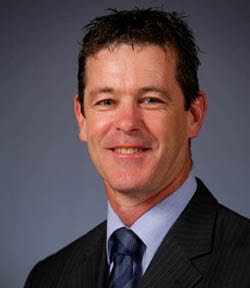Last week, Victorian Premier Denis Napthine injected new blood into his frontbench in preparation for the state election this November, promoting member for Morwell Russell Northe as Minister for Energy and Resources.

Northe steps into the role at a time of great uncertainty surrounding the energy sector. The Abbott government’s stacked RET Review clouds the prospects for renewable energy in the country and compounds the impact of Victoria’s anti-wind farm laws. The rooftop solar boom continues to disrupt the business model of the big fossil-fuel-based energy companies and the last scrap of coal power’s social licence went up in the recent fire at the Hazelwood coalmine.
The context of energy policy (and politics) is well known. Yet Victoria’s new energy minister is Russell Northe is somewhat of an unknown quantity. Yes 2 Renewables had a look over Northe’s record to get a better sense of the man. Here’s what we found.
In his home electorate of Morwell, Russell Northe has been a consistent proponent of investment in energy alternatives insomuch as these do not conflict with the local economy. Northe has been particularly concerned with protecting the community from the inevitable employment changes the renewable energy transition would throw up in Victoria – namely, the reduced need for one of the world’s most polluting coal power plants, Hazelwood.
In July 2010 press release Northe stated:
“The concern for the Latrobe Valley community should be that future renewable energy would be strategically placed outside of our region and this could potentially lead to loss of local jobs.”
And in May of that year:
“Latrobe Valley must be part of the solution before there is any more talk of Hazelwood Power Station being switched off early”
It is unclear whether the recent month-long fire at the Hazelwood mine, and the dispersal of the dangerous levels of particulate matter that followed, has yet to convince the incumbent minister of the importance of mothballing the plant.
In the meantime, the Napthine government has given every indication that it intends to expand its dirty brown coal-producing industries by ensuring a set of grants designed to encourage the export and conversion (into oils and fertilisers) of coal based products. But the associated conversion technologies, according to the Age, “are in early development stages, unproven and remain greenhouse gas intensive.”

In the past, Minister Northe has proposed alternatives such as “solar, wind, geothermal or otherwise” in the Latrobe Valley and Gippsland regions while also remaining open to the use of so-called ‘clean coal’. But Northe’s position would appear to be in conflict not only with the fact that capture and storage technologies remain highly undeveloped and uneconomical, but also with his party’s ongoing support for ex-Premier Ted Ballieu’s anti-wind farm laws.
“This [wind energy] policy has been well understood for a long period of time,” Northetold The Latrobe Valley Express, “and we believe it strikes the right balance between community needs and provides some certainty for wind energy development.”
Russell Northe’s assessment of wind energy regulations doesn’t reflect the reality. A mere 24 turbines have been approved in Victoria under the Coalition government which pales in comparison to the record of the Bracks and Brumby Labor governments. Friends of the Earth research found the anti-wind farm laws have cost the state:
- Around $887 million in lost or stalled investment
- 650 direct jobs lost or stalled in construction
- 54 on-going jobs in management of wind farms
- 408 indirectly associated (flow-on) jobs. (MR 2013)
Minister Northe could push for restoring fair wind farm planning laws and protect the government from taking a damaging anti-renewable energy policy to the November 29 election. Lack of action from previous energy ministers O’Brien and Kotsiras does not inspire confidence in that occurring.
When it comes to solar, Northe expressed the view in May last year that solar feed-in tariffs crucial to expansion here may need to be wound back:
“As we have seen in other jurisdictions, the feed-in tariff rate has dropped substantially. In some cases in other jurisdictions there is no feed-in tariff at all, because what you effectively have is the subsidisation of those who can afford solar rather than of those who cannot. It is generally those who cannot — those who can ill afford to pay for electricity — who are subsidising others.”
The argument that residential solar is the domain of the rich, however, has effectively been laid to rest, given that the greatest take up in Victoria has occurred not in its wealthiest areas but in those where rising power prices will hurt the hardest, such as Melbourne’s ‘new’ and outer suburbs.
The Abbott government’s RET Review is perhaps the first test for Minister Northe. By throwing his weight behind the 41,000 GWh target Northe can improve the prospects of already approved wind farm projects. Newly elected Tasmanian Premier Will Hodgman has backed the RET, so leadership from Northe is not out of question.
What type of energy minister will Northe be? We’ll soon find out. Northe has between now and November to prove himself before Victorians head to the polls.
Source: Yes 2 Renewables. Reproduced with permission.










